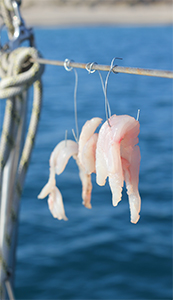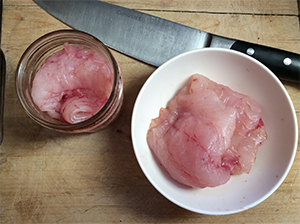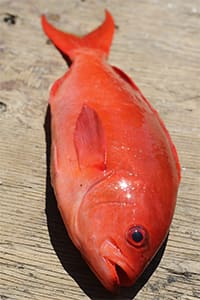If you’ve ever attempted to eat fish three meals a day, you can appreciate the importance of preservation methods. Fortunately there are several refrigeration-free techniques that not only preserve fish on board but also produce a variety of delicious textures and flavors.
As when preserving any food, make sure to always work with sanitized hands, surfaces and equipment. Improper practices can result in food-borne pathogens like Salmonella, E. coli or C. botulinum. Careful practices will ensure safe food.
So what is preservation all about? The aim of preservation is to protect fish from the putrefying bacteria and enzymes that cause it to rot. This is done by creating an environment in which the bacteria cannot survive (e.g. lack of moisture, high temperature, lack of oxygen). The methods outlined below each accomplish this in different ways, producing varying shelf lives, textures and flavors.
 |
|
One way to preserve fish is to take it ashore and smoke it on the beach in a smoker. |
Corning
When the weather is warm and there’s no refrigeration, corning will keep a fish for up to 24 hours, making it a popular method with sports fishermen. You’ll require 6 percent of the fish’s body weight in fine-grained salt.
Method: Gut, bleed and wash the fish, then apply salt to the belly cavity and skin. In warm weather do this ASAP so that the salt penetrates, reducing water content before the flesh can spoil. Put the fish in a container and cover with a damp cloth. For corning to work, you must add more salt than is palatable, so once you’re ready to cook you can either use the cured fish to salt stews and sauces, or soak it in water for a couple of hours before cooking.
Brine-salting
Brine-salting, the method used for Scandinavian salted herring, keeps fish for up to nine months. You’ll need a crock or glass container, as well as several cups of fine-grained salt. This is a great technique for lean fish like salmon, rockfish, mackerel and herring.
 |
|
Cleaning and filleting the fish. |
Method: Roll fish in salt and layer in the crock, adding salt to the bottom and between each layer. Salt will draw water out of the flesh, creating brine that inhibits certain microorganisms and enzymes. Place a weight on the fish to submerge them in the brine and to prevent spoilage. Small fish (8 pounds or less) should cure for two days; larger fish may require up to 10 days. Once cured, repack the fish in fresh salt and store below 70° F. Before cooking, rinse and soak the fish for several hours.
Drying
Drying is a popular method among sailors, perhaps because it doesn’t require specialized equipment or a large supply of salt. Properly dried fish should keep for up to two months.
Method: Clean and fillet the fish, slicing it into thin quarter-inch strips. Hang the strips out to dry in the hot sun — 1-5 knots of breeze is helpful too — with thread or thin wire. After 12 hours, the strips should develop a dried protective coating (the insides will dry more slowly over time). Bring the fish in at night to avoid dew. As the fish continues to dry, the lack of water will suspend all microbial activity. Once dried, fish can be used in soups and stews or even crushed as a condiment.
 |
|
Drying fish on hooks on the lifeline. |
Smoking
In cold and humid climates, the sun cannot dry the fish fast enough and putrefaction sets in. Smoking is therefore a great option because it not only preserves the fish for several months (through drying and anti-microbial compounds), but it also has a very rich and distinctive taste. You can either buy a smoker or improvise one with materials at hand; in either case it’s probably better to fire it up on the beach, away from your sailboat.
Method: Clean and fillet the fish, then soak in brine for three to 10 hours (depending on the size of the fish). Build a fire in your smoker and then smother it with green wood. Smoke the fish for a minimum of one day, or longer if you don’t plan to gobble up the lot at happy hour.
Canning
Canning is the preferred method for preserving fish amongst sailors due to its ease and reliability. You’ll require several mason jars with self-sealing lids and a pressure cooker, as it’s the only way to get a high enough temperature for safe canning.
 |
|
Canning fish in mason jars. |
Method: Fill a pint-sized sterilized mason jar with fish, leaving an inch of space at the top. Add one teaspoon of salt and screw on the lid. Place the can upright in the pressure cooker with enough water to cover two-thirds of the can. Cook for one hour and 45 minutes at 10-15 pounds of pressure. Canned fish works well in a variety of meals, including my personal favourite: battered and fried in fish tacos.
With some basic supplies and a bit of time, keeping fish on board can be quite straightforward. The methods above should hold you in good stead, keeping your galley stocked with a variety of long-lasting fish options.
Fiona McGlynn and her partner Robin left Vancouver in 2015 in their Dufour 35, MonArk. Read about their (mis)adventures and “boatsteading” DIY tips at www.happymonarch.com.

